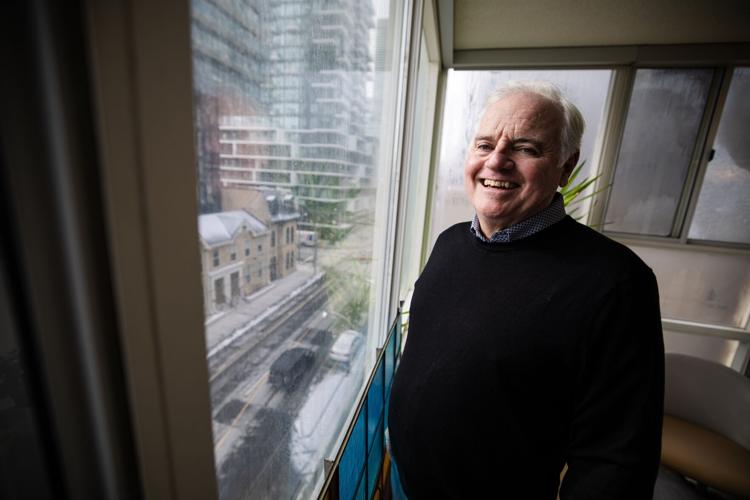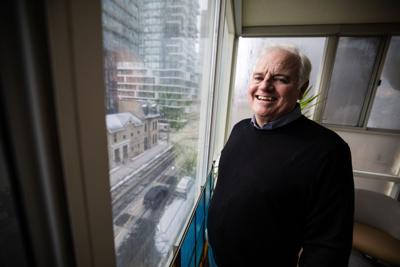Patrick McConkey moves around the kitchen, starting coffee and offering to make tea. Sunlight pours into a solarium just off the kitchen, filling the space with warm beams. The atmosphere here feels cosy and inviting, more like a home than a clinic. And at an end-of-life care facility for homeless people, that is the point.
Each week, McConkey, who retired 10 years ago from a career at IBM, volunteers as a companion at the hospice. His role is simple but profound: to be present with patients through their final days. He’s been volunteering to do so for two years.
One resident walks into the kitchen from her room and sits looking toward the sun streaming in through the solarium. McConkey asks her if she wants tea or coffee. She requests a coffee, which McConkey brings, allowing her to add her own milk and sugar.

Saint Elizabeth health employee Greg Cheron begins to prepare dinner for residents. 
Nick Lachance pc28╣┘═°StarJourney Home Hospice is a program of the Saint Elizabeth Foundation, a national charity that supports end-of-life care for vulnerable people across Canada. Hosted by Homes First Society, a Toronto-based charity that provides affordable housing, the hospice is located in the cityÔÇÖs Moss Park neighbourhood and offers 13 beds.
Patients are each provided their own rooms, which includes a personal fridge. Common spaces like a sunroom, rooftop patio, and areas for art therapy are also available. Three meals a day are made on site by volunteers (or personal support workers when volunteers are not available), and there is a snack cart for patients whenever they wish. Visitors ÔÇö family and friends ÔÇö are welcome.
“Many times, people living on the streets can be isolated or alone, and the only family they might be in contact with is their street family,” said Nancy Lefebre, senior vice president and COO of Journey Home Hospice. ÔÇťOur volunteers become part of their, ÔÇśfound familyÔÇÖ, and are the heart of our hospice,” she said.
To operate the 24-hour hospice, Journey Home relies on volunteers to help in three main areas: greeting visitors, a companion role to spend time with residents, and helping with food prep and baking. ÔÇťThose kinds of things, like the smell of baked bread, make it feel much more like a home environment,ÔÇŁ Lefebre said.
As companions, volunteers engage with patients in a variety of ways ÔÇö whether it’s watching TV together, listening to music, reading, participating in art therapy, or even going for a walk, if the patient is able.┬áTheyÔÇÖre also there in the final moments, providing support until the patient passes away.

A volunteer at Journey Home Hospice in Toronto’s Moss Park neighbourhood takes a walk with a resident.
Nick Lachance pc28╣┘═°StarMcConkey recalls his first experience sitting with a patient who died. “She had a master’s degree in science. She was from another country and came here to try and make it,” McConkey said. “I remember how hard I took that because I got to know her.”┬á
Volunteers in the companion role donate around 460 hours per month, totalling more than 5,500 hours annually.
Currently, the hospice has 60 dedicated volunteers. ÔÇťOverall, we need about 150 volunteers, which is why we’re always actively seeking new volunteers,ÔÇŁ said Lefebre. She said volunteers go on vacation, take a leave, get sick and ÔÇťyou need a lot of individuals to ensure that there’s coverage for the programs for 24-7.”
Another resident joins the small group in the kitchen. Next, he is doing laps in his wheelchair through the hall and McConkey walks beside him, encouraging him, saying it will help his goal of keeping up his strength.
ÔÇťIÔÇÖm not much of a talker,ÔÇŁ he said.
Later, he requests a cigarette break, and a volunteer accompanies him outside.
To ensure volunteers are fully prepared, Journey Home Hospice offers mandatory training, as well as ongoing support. ÔÇťWe have lots of supports and resources for our volunteers,ÔÇŁ said Lefebre, ÔÇťAll of the supports that we provide to our patients are also there to support staff and volunteers,ÔÇŁ she said, ÔÇťwe have regular meetings with volunteers just to check in.ÔÇŁ
ÔÇťThere’s a lot of compassion and volunteer centered support for people that are volunteering their time because we’re so deeply grateful for their involvement,ÔÇŁ said Lefebre.┬áVolunteers well suited to the companion role, ÔÇťhave to be, nonjudgmental, very open, caring, kind, and patient” she said, adding that anyone interested in volunteering can find information on the website, .
ÔÇťIt’s not a very lively, active place. People are at various stages in their trajectory of health,ÔÇŁ said Lefebre, ÔÇťbut there is a lot of living going on here.ÔÇŁ






























To join the conversation set a first and last name in your user profile.
Sign in or register for free to join the Conversation